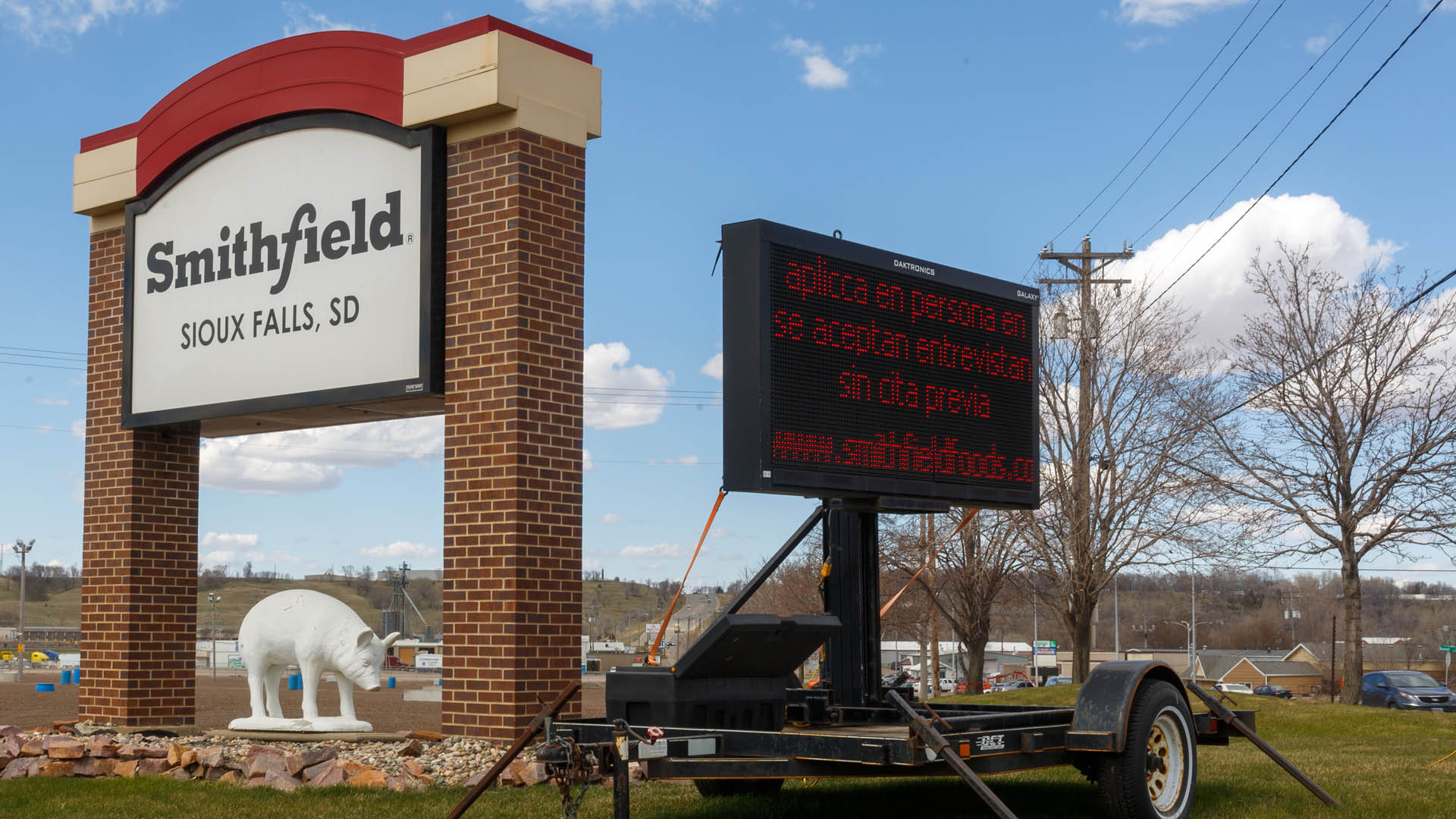Meat Packing Plants and More: Your Covid-19 Questions, Answered
As the coronavirus pandemic continues to spread, Undark readers have been sending us numerous and often insightful questions, comments, and observations on the subject. We’ve asked the Pulitzer Prize-winning science journalist and Undark’s publisher, Deborah Blum, to dedicate some time to responding — both as a reader service, and as another way for Undark to cast some light into the darkness of misinformation, rumor, fear, and conjecture now percolating through the information commons.
You can find previous iterations of this feature here. And if you have questions, comments, or would like to see some other aspect of the Covid-19 crisis explored in a subsequent feature, please write us at: [email protected]. (Reader questions and comments below have been edited and sometimes combined for clarity and brevity.)
Can we pinpoint the source of the Smithfield meat plant infection, considering it is owned by China, and mightn’t Chinese managers have flown into Smithfield? This might illustrate that the virus is being exported out of China, maybe unknowingly.
Thanks for this provocative question. It allows me to address a couple of issues that have caused a lot of confusion and concern. One is about the role of Smithfield ownership and the other is the bigger and more critical question of why meat packing plants in general have become such notable Covid-19 hotspots over the last few weeks.
The short answer: It’s unlikely that the infections at Smithfield were directly seeded from China.
The long answer: Smithfield Foods, best known as a meat-processing company, was founded in Virginia in the 1930s. It was acquired in 2013 by the Hong Kong based WH Group, which bills itself as “the largest pork company in the world.” Hong Kong, a special administrative region of China since 1997, has an excellent record on managing Covid-19. The WH Group is a publicly traded company; you can purchase shares yourself on the Hong Kong Stock exchange under the code 00288. The U.S. operations are still headquartered in Smithfield, Virginia — the company operates as an American business and pays taxes here — and is run by an American management team, according to the company website. The company also states that: “Smithfield has not, does not, and will not import any products from China to the United States. No Smithfield products come from animals raised, processed, or packaged in China.”
So it’s most likely that infections in meat packing operations originated here in the United States. It’s also likely that due to the intensity of Covid-19 rates in these facilities, you can expect more research on this issue in the future.
And while Covid-19 outbreaks have occurred at Smithfield plants from South Dakota to Wisconsin to North Carolina, these are far from the only meat and poultry processing facilities that have become coronavirus hotspots. Cargill closed beef processing plants from Alberta, Canada to Hazleton, Pennsylvania after hundreds workers became infected. The huge Brazil-based meat packing conglomerate JBS SA closed several of its U.S. packing houses even while continuing operating others in midst of rising infection. After it reopened a Colorado plant, Covid-19 cases rapidly spiked again. JBS operated plants in Texas’s Panhandle region have been linked to the highest rate of coronavirus infections in the state. Similar problems have been reported by the poultry giant Tyson. Hundreds of Georgia poultry workers have tested positive for the coronavirus as well. This week, Investigate Midwest reported that more than 11,000 packing house employees have so far been infected nationwide and that dozens have died.
So it’s worth looking at some of the factors actually driving this wave of packing house infections — and the community spread that follows.
In many ways, unfortunately, modern food-processing plants turn out to be near perfect incubators for the spread of new and highly infectious viruses. For instance, recommendations for slowing Covid-19 transmission emphasize avoiding contact with others and social distancing of at least six feet of separation. In standard packing plant operations, employees work on a line, sometimes inches apart, and they are, by nature of the job, in constant contact with others. The plants are crowded — by one estimate, a worker at the large JBS plant near Green Bay, Wisconsin, can easily have contact with 1,000 people a day. And work is done in an enclosed facility where the air is both recirculated and often chilled to protect meat supplies, near ideal conditions for a respiratory virus since there is evidence that airborne viruses — certainly influenza — find it easier to spread through cold, dry air.
As has also been reported, the big meat processing companies moved slowly to protect their workforce and rarely offer sick leave, meaning that even when infected, employees have been going to work. As critics point out, some of this results from imbalance of power, as many of the workers are immigrants with little political clout. This is nothing new in the history of meat processing. Even more brutal conditions were described in Upton Sinclair’s 1906 novel, “The Jungle,” famously set amid the horrors of the Chicago stockyards. In the face of today’s mounting crisis, processors insist they are following government guidelines on issuing protective equipment. But worker advocates and even some legislators have expressed concern that personal protective equipment (PPE) supplies remain inadequate and that protecting line workers has yet to be a real priority.
“The people who prop up life here, the ones now getting sick or working in fear wondering when they will, have little power over what the coronavirus is doing to their lives, because they have little power here at all,” a reporter at The Texas Tribune wrote about the growing outbreak in the state’s Panhandle region. This week, Wisconsin’s Supreme Court Chief Justice Patience Roggensack was widely criticized for saying that it was only meat packing employees who were being sickened, not “the regular folks.”
Researchers who study food-processing operations caution that the kind of radical changes needed to deeply reduce infections pose a daunting challenge in the fast-paced, high-intensity operations of meat processing today. Even with increased protection at the plants, the virus is still spreading with real success. Despite an April 28 order by President Trump for the plants to remain open as essential businesses, an additional seven facilities have closed in the last week, leading to early signs of meat shortages in the U.S. food supply chain.
Still, companies are making moves to slow the spread of virus — installing shields, slowing the lines, even adding some distance requirements. The latest Morbidity and Mortality Weekly Report from the U.S. Centers for Disease Control and Prevention surveyed the problem in 19 states and issued a detailed analysis and set of recommendations for the plants: “Improving physical distancing, hand hygiene, cleaning and disinfection, and medical leave policies, and providing educational materials in languages spoken by workers might help reduce Covid-19 in these settings and help preserve the function of this critical infrastructure industry.”
If the virus lives only a few days on most surfaces, why can’t PPE be recycled, whereby it rests for about five days before being reused?
Unfortunately, the virus seems to endure on different surfaces for varying lengths of time. In some rare cases (as discussed in this earlier Reader Q&A) scientists have found at least traces of the coronavirus on surfaces for up to two weeks, so guaranteeing the safety of PPE just by giving it a resting period is probably not ideal. But due to ongoing shortages of the protective equipment, health care providers have been looking at ways to sterilize and reuse it. The CDC has issued some guidance on sterilization methods ranging from UV light to hydrogen peroxide vapor. And hospitals and medical centers across the country are adopting a range of strategies for safely reusing masks and other protective gear due to an ongoing PPE shortage. In fact, one site in Somerville, Massachusetts has the ability to sterilize 80,000 masks a day for reuse.
Could fleas, ticks, mosquitoes, and other biting insects be transmission sources for Covid-19?
This is definitely a timely question as summer approaches. And given that, I’m happy to tell you that it appears that insect or tick transmission of the coronavirus is extremely unlikely. The kinds of infections transmitted by such vectors involve microorganisms that are transmitted through blood, such as the parasite that causes malaria or the bacteria linked to Lyme disease. By contrast, Covid-19 is a respiratory virus, spread through microscopic droplets that are exhaled by infected persons. Insects and other arthropods are not good hosts for respiratory viruses; they don’t tend to replicate well in such systems, entomologists say. Here’s an excellent and reassuring explanation from a New England entomologist: “Should a mosquito take up the blood of somebody who is infected with a disease that hasn’t evolved in a way to get out of the gut, it just gets digested with the rest of the blood that the mosquito has taken up so no, there’s no way.” The World Health Organization also makes a point of dismissing insect transmission in its Covid-19 myth-buster series.
That’s it for this installment, but if questions or observations occur to you as this pandemic moves forward, don’t hesitate to contact us. We’ll do our best to include your input or otherwise provide you with realistic answers — and we can promise you they’ll be well-researched ones. Please email us at [email protected].












Comments are automatically closed one year after article publication. Archived comments are below.
Are the meat and packaging tested and/or infected by those meat plants Inundated with covid 19 and left open by stupidity? Isn’t it time to hold those governors responsible for the deaths of plant workers infected and those infected by the meat and packing?